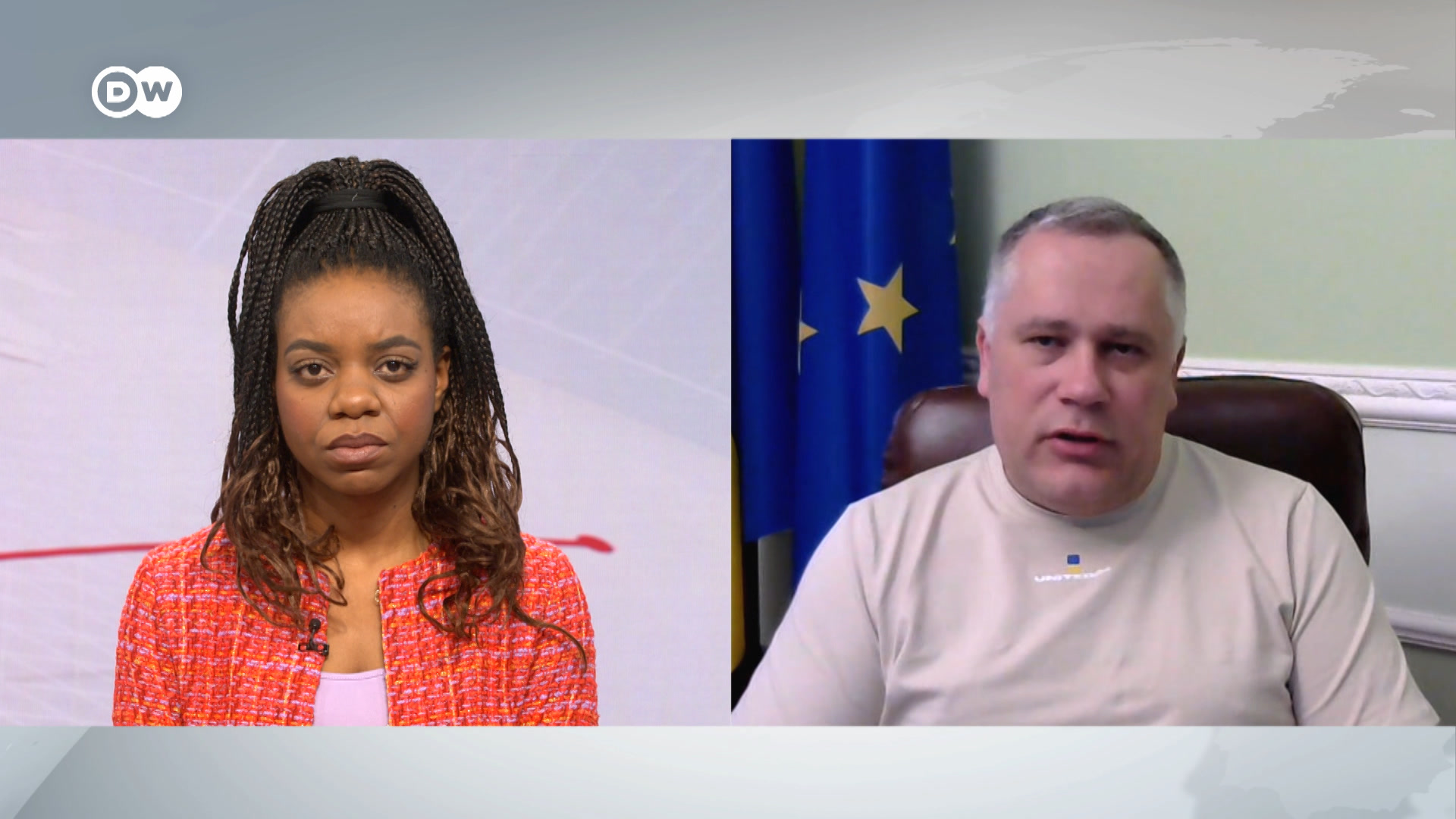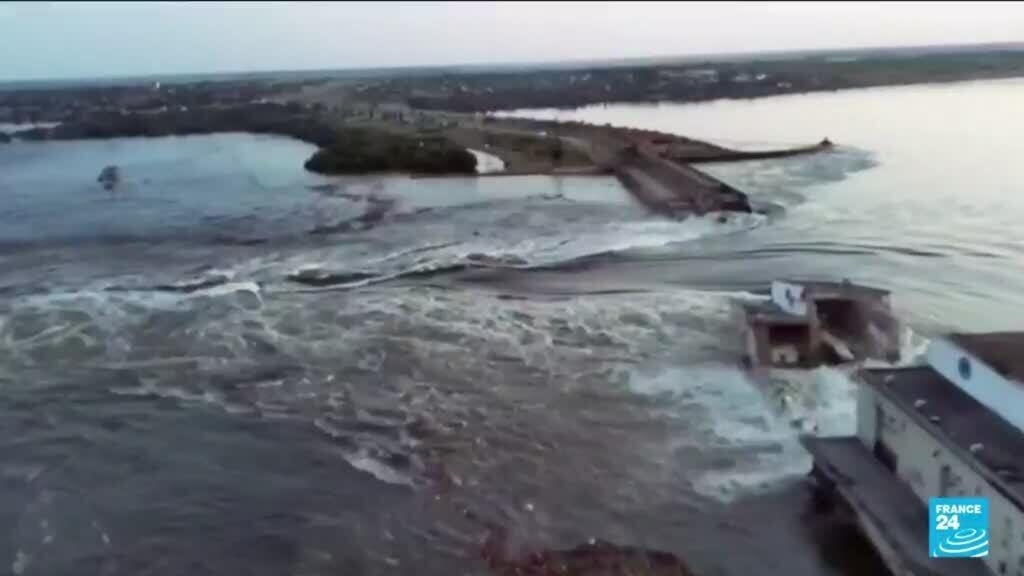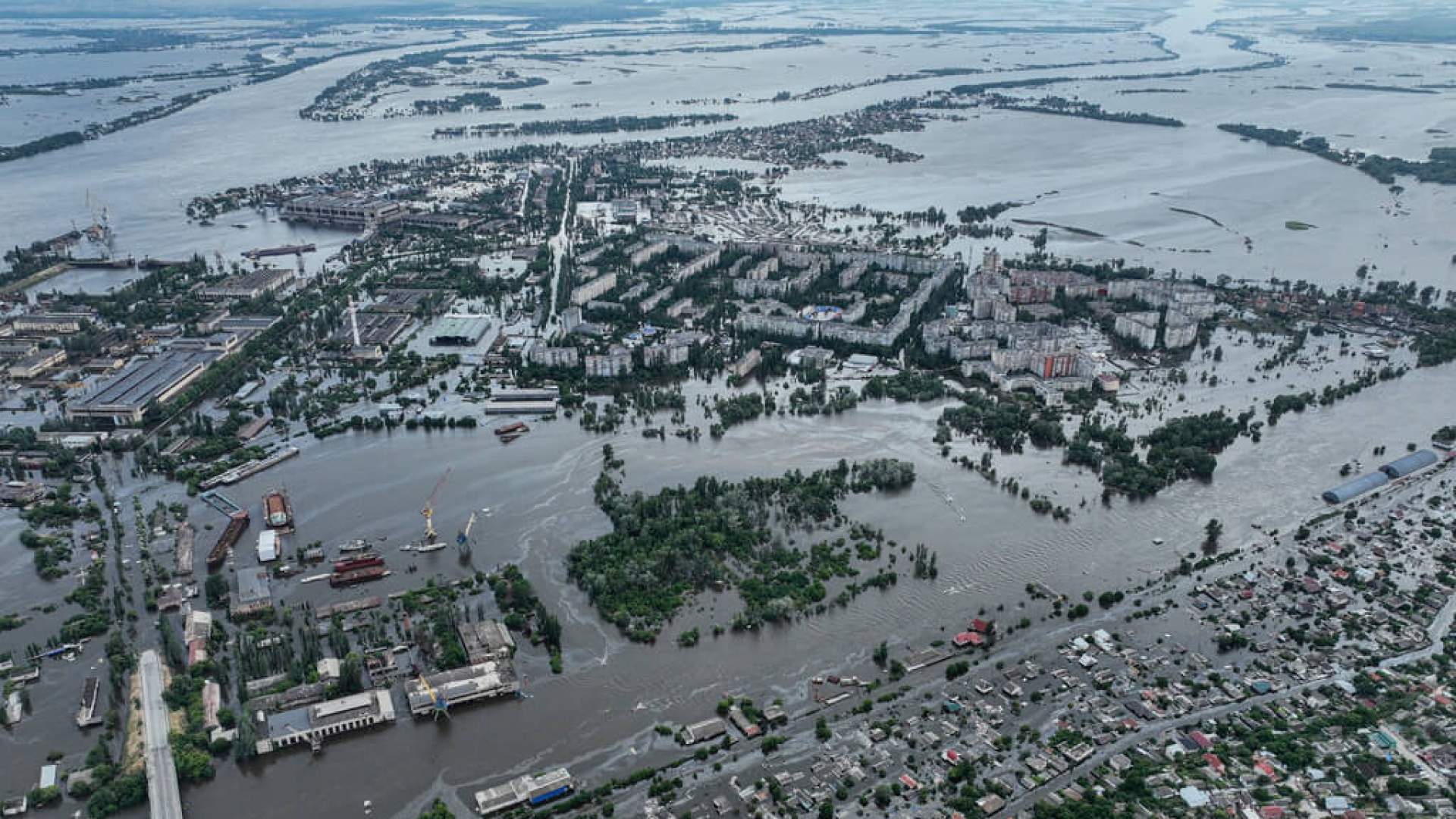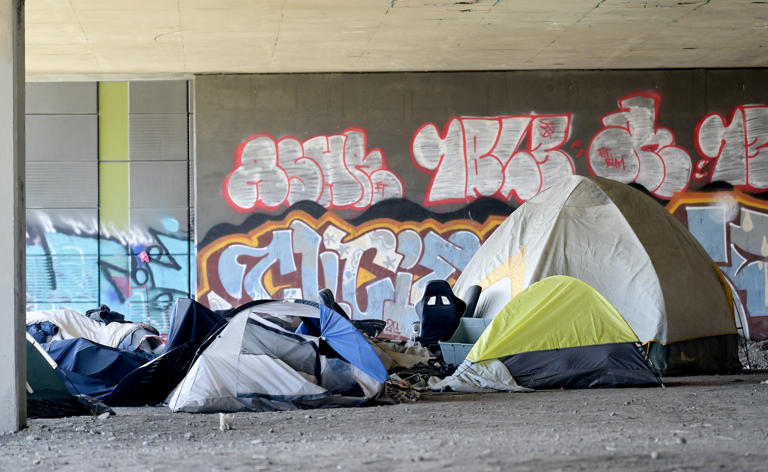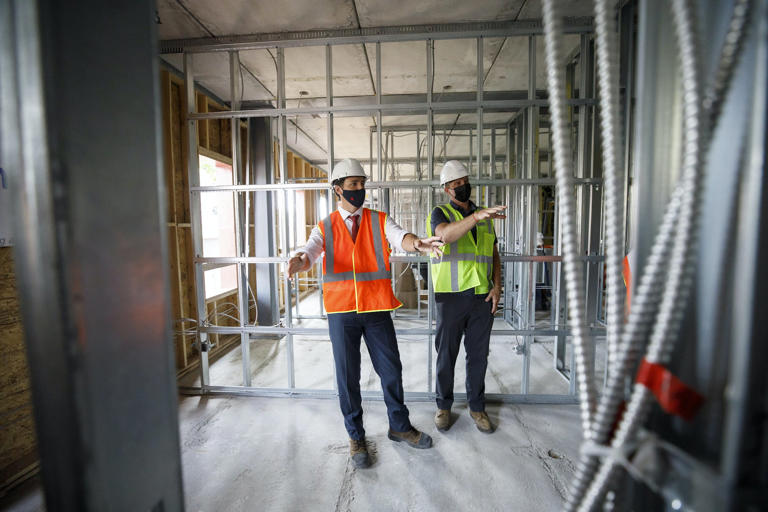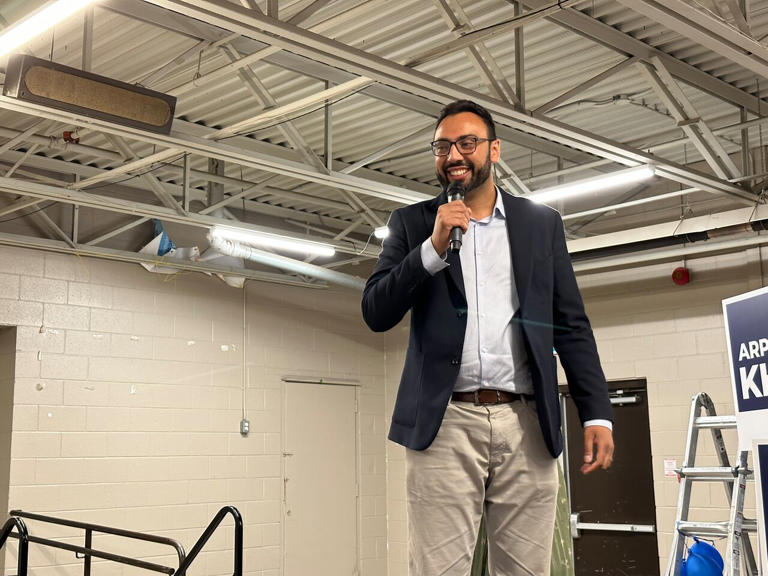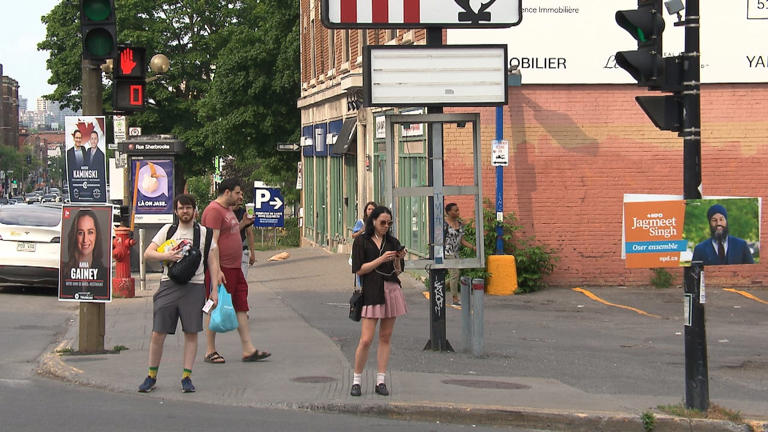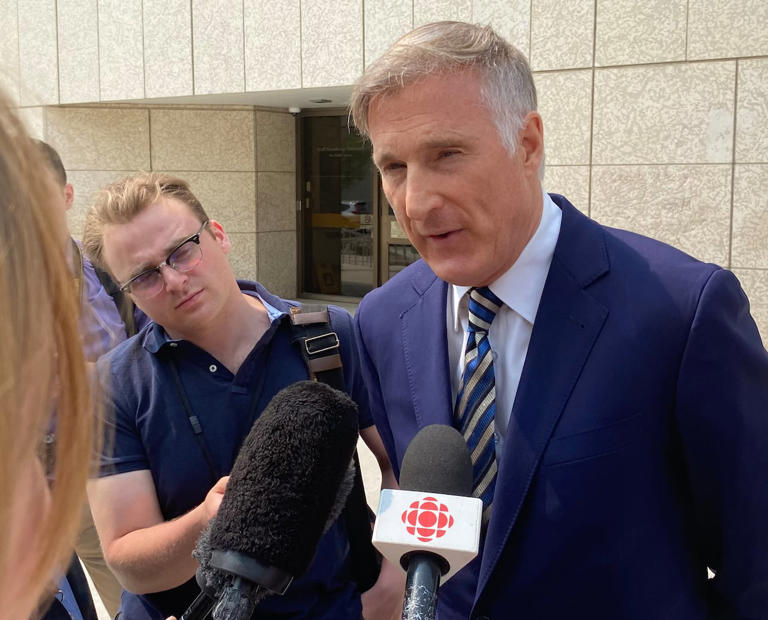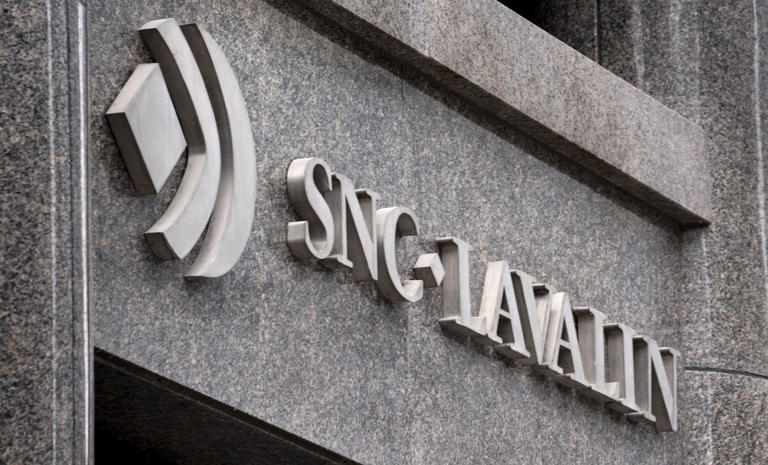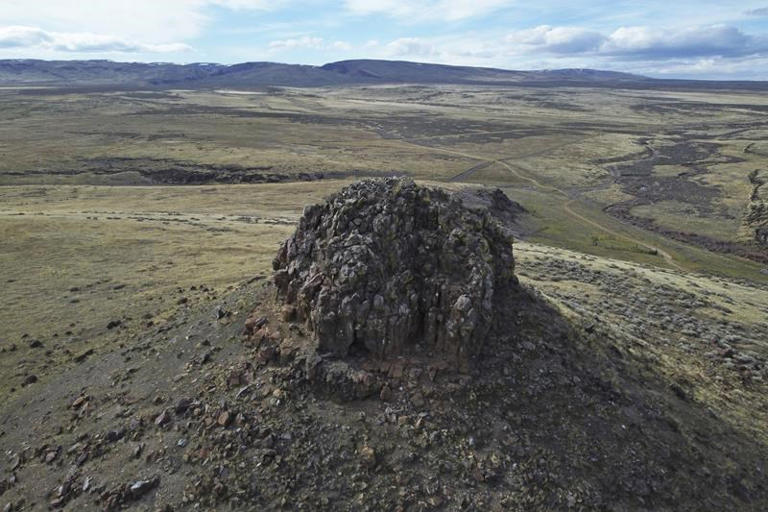
BERISLAV, Ukraine (AP) — Russia had the means, motive and opportunity to bring down a Ukrainian dam that collapsed earlier this month while under Russian control, according to exclusive drone photos and information obtained by The Associated Press.
Two officials said Russian troops were stationed in a crucial area inside the Kakhovka Dam where the Ukrainians say the explosion that destroyed it was centered. Images taken from above and shared with the AP also appear to show an explosives-laden car atop the structure. It’s not clear the car ever exploded and any such bomb would not have been powerful enough to bring down the dam, but Ukrainian officials say the photos show the Russians’ intent to rig it, and that they had the access and control to do so.
The dam’s destruction led to deadly flooding, endangered crops in the world’s breadbasket, threatened drinking water supplies for thousands and unleashed an environmental catastrophe. Ukrainian commanders say it also scuppered some of their plans to take Russian positions in a counteroffensive that is now in its early stages.
Each side has accused the other of destroying the dam, but the various Russian allegations — that it was hit by a missile or taken down by explosives — fail to account for a blast so strong that it registered on seismic monitors in the region.
Russia has benefited from the timing of the massive flooding that followed the explosion — though areas it occupies also experienced a deluge and the consequences may have been more extensive than expected. The Russian Defense Ministry did not immediately respond to a request for comment.
In the region around the dam, the Dnieper River forms the front line between Russian and Ukrainian forces, with Russian ones in control of the dam itself.
Two Ukrainian commanders who had been in the area but at different locations told the AP that the rising waters quickly swamped their positions and Russian ones and destroyed equipment, forcing them to start all over again with their planning and leaving them facing a much larger distance to cover, all in mud. One spoke on condition of anonymity in order to reveal more frankly the extent of the problems caused by the rising waters.
“It’s a regular practice, to mine (places) before a retreat,” said the other, Illia Zelinskyi, commander of Bugskiy Gard. “In this context, their actions were to disrupt some of our supply chains as well as complicate a crossing of the Dnieper for us.”
In recent weeks, Ukraine’s armed forces have reported limited gains in the beginnings of a counteroffensive to take back territory seized by the Russians since their invasion in February 2022.
Russian President Vladimir Putin himself indirectly acknowledged the advantage to his forces last week, although he maintained Russia’s denials of responsibility: “This may sound weird, but nonetheless. Unfortunately, this disrupted their counteroffensive in that area.”
Speaking before a meeting of military correspondents, he explained his use of the word “unfortunately” with bravado: “It would have been better if they had attacked there,” he said. “Better for us, because it would have ended very badly for them, attacking there.”
In the days leading up to the dam's destruction on June 6, Ukrainian military drone videos showed dozens of Russian soldiers encamped on a bank of the Dnieper, relaxed as they walked back and forth to the dam with no cover — suggesting their confidence in their control of the area and especially the dam, which was strategically crucial.
Photos from drone footage obtained by the AP and dated May 28 showed a car parked on the dam, its roof neatly cut open to reveal enormous barrels, one with what appears to be a land mine attached to the lid and a cable running toward the Russian-held side of the river.
Related video: Russia likely behind Ukraine dam collapse - experts (Reuters)
Duration 1:17 View on Watch
WIONUkraine dam breach: Russia-Ukraine blame game continues
2:14
DW Ukraine and Russia trade blame for destruction of dam
6:26
It’s not clear any car bomb ever went off. A satellite image from June 16 shows a fuzzy object on top of the dam that could be the vehicle — but it was taken at such a distance and resolution as to make it impossible to know for sure.
A Ukrainian special forces communications official said the drone photos are evidence the dam was rigged. He said he believed the purpose of the car was twofold: to stop any Ukrainian advance on the dam and to potentially amplify the planned explosion originating in the machine room. Even if the car exploded, it would not have been sufficient to bring down the dam. The official spoke on condition of anonymity to preserve operational secrecy.
Kakhovka is one of a series of Soviet-era dams along the Dnieper River that were built to withstand enormous force, amounting to thousands of pounds of explosives. They were constructed in the wake of the infamous World War II “Dambusters” raids that destroyed German dams. Taking out the Möhne dam in 1943, for instance, required five 4.5-ton, specially made “bouncing bombs,” according to the Imperial War Museum archives.
Ukraine is not believed to possess any single missile with that kind of power.
Sidharth Kaushal, a researcher with the London-based Royal United Services Institute, said the Ukrainians are not believed to have any missiles with a payload greater than about 1,100 pounds (500 kilograms).
Nor does it seem credible that Ukrainian commandos could have sneaked in thousands of pounds of explosives to blow the dam, which was completely controlled inside and out by Russian soldiers for months.
As recently as the day before the structure’s collapse, Russians had set up a firing position inside the dam’s crucial machine room, where Ukrhydroenergo, the agency that runs the dam system, said the explosion originated. Ukrainian President Volodymyr Zelenskyy said as early as October 2022 that the dam was mined.
Zelinskyi, who is not related to the Ukrainian president, confirmed that the explosion seemed to come from the area where the machine room is located. He and an American official familiar with the intelligence both confirmed that Russian forces had been ensconced there for some time. The American spoke on condition of anonymity to discuss sensitive material.
The Institute for the Study of War, an American think tank that has monitored Russian actions in Ukraine since the war began, has assessed that “the balance of evidence, reasoning, and rhetoric suggests that the Russians deliberately damaged the dam.”
The explosion detected at 2:54 a.m. local time registered on Norwegian seismic monitors at nearly magnitude 2. By comparison, a catastrophic explosion at Beirut’s port that killed scores of people and caused widespread destruction registered at a 3.3 on the seismic scale and involved at least 500 tons of explosives.
“That means it’s a significant explosion,” said Anne Strømmen Lycke, CEO of the Norwegian earthquake monitoring agency NORSAR.
Within a few minutes, water from the Kakhovka reservoir began cascading through the shattered dam, submerging the river’s sand bar islands and flooding much of southern Ukraine, including Russian-controlled territory.
Immediately after the dam’s collapse, some experts noted that the structure was in disrepair, which could have led to the breach. But the area most obviously in disrepair, a section of roadbed near the edge where Russian forces had detonated explosives to block a Ukrainian offensive last fall, was still intact days after most of the rest of the dam collapsed.
Ukraine’s intelligence service released an intercepted conversation it said was between a Russian soldier and someone else in which the soldier said “our sabotage groups were there. They wanted to create a scare with the dam. It didn’t quite go according to plan.”
___
Hinnant reported from Paris. Aamer Madhani in Washington and Illia Novikov in Kyiv, Ukraine, contributed.
___
Follow AP’s coverage of the war in Ukraine: https://apnews.com/hub/russia-ukraine
Mstyslav Chernov And Lori Hinnant, The Associated Press
UN complains Russia blocks aid workers from area of Ukraine dam collapse; Moscow says it's unsafe

KYIV, Ukraine (AP) — The Kremlin's spokesman said Monday that U.N. aid workers who want to visit areas ravaged by the recent Kakhovka dam collapse in southern Ukraine can’t go there because fighting in the war makes it unsafe.
The United Nations rebuked Moscow on Sunday for allegedly denying aid workers access to Russian-occupied areas where residents are stranded amid “devastating destruction.”
The U.N. humanitarian coordinator for Ukraine, Denise Brown, said in a statement that her staff were engaging with both Kyiv and Moscow, which control different parts of the area, in a bid to reach civilians in need. They face a shortage of drinking water and food and a lack of power.
Brown urged Russian authorities “to act in accordance with their obligations under international humanitarian law” and let them in.
Kremlin spokesman Dmitry Peskov didn’t explicitly admit that Russia had blocked U.N. access, but told a conference call with reporters that Ukrainian attacks made a visit too risky.
“There has been constant shelling, constant provocations, civilian facilities and the civilian population have come under fire, people have died, so it’s really difficult to ensure their security,” Peskov said.
His comments came amid varying accounts by survivors of the quality of assistance that Russia is providing in areas it controls. The dam lies on the Dnieper River, which forms the front line between Russian and Ukrainian forces on the eastern and western banks, respectively.
Many evacuees and residents accuse Russian authorities of doing little or nothing to help. Some civilians said that evacuees were sometimes forced to present Russian passports if they wanted to leave.
On the Ukrainian side, rescuers are braving Russian snipers as they rush to ferry Ukrainians out of Russia-occupied flood zones.
Ukraine's Minister of Internal Affairs Ihor Klymenko said Monday that the death toll resulting from the dam collapse had risen to 18 — 14 from drowning and four from gunshot wounds sustained during evacuation. A further 31 people were missing, he said.
Ukraine's presidential office said Monday that the Kherson region affected by the flooding had endured 35 Russian attacks over the previous 24 hours.
Exclusive drone photos and information obtained by The Associated Press indicate that Moscow had the means, motive and opportunity to blow up the dam, which was under Russian control, earlier this month.
The explosion occurred as Ukraine mustered for a counteroffensive. Kyiv's forces have intensified attacks along the 1,000-kilometer (600-mile) front line recently.
Some analysts saw the dam breach as a Russian effort to thwart Ukraine's counteroffensive in the Kherson region.
The U.K. Defense Ministry said Monday that Russia had recently redeployed several thousand troops from the banks of the Dnieper to buttress its positions in the Zaporizhzhia and Bakhmut sectors, which reportedly have seen heavy fighting.
The move “likely reflects Russia’s perception that a major Ukrainian attack across the Dnieper is now less likely” following the dam’s collapse, the ministry said in a tweet.
Ukrainian forces have advanced up to 7 kilometers (4 miles) into territory previously held by Russia, she said. Russia’s Defense Ministry didn’t confirm losing any ground to the Ukrainian forces.
In response to “increased attacks by the occupiers,” Ukrainian President Volodymyr Zelenskyy said Monday in his nightly address that Ukrainian soldiers were “moving forward in some directions, defending their positions in some directions.”
“We have no lost positions. Only liberated ones,” he asserted.
It wasn't possible to independently verify battlefield claims by either side.
Russia is also pursuing offensive actions, according to Ukrainian Deputy Defense Minister Hanna Maliar.
Russia has concentrated a significant number of its military units, and particularly airborne assault troops, in Ukraine’s east, she said. They are stepping up Moscow’s offensive around Kupiansk in Ukraine’s northeastern Kharkiv province and Lyman in the eastern Donetsk province, Maliar said on Telegram.
Ukrainian forces may have put their counteroffensive operations on hold as they review their tactics, according to the Institute for the Study of War, a Washington-based think tank.
It noted that Kyiv “has not yet committed the majority of its available forces to counteroffensive operations and has not yet launched its main effort.”
Russia attacked south and southeast Ukraine overnight with cruise missiles and self-exploding drones, Ukraine’s air force reported Monday. Four Kalibr missiles and four Iranian-made Shahed drones were shot down, it said.
According to regional officials, the southern province of Odesa and the southeastern Dnipropetrovsk region were targeted by the attack. No casualties or damage were immediately reported.
Three civilians were wounded by artillery fire in the Beryslav district of the Kherson province Monday, local officials said. A 64-year-old woman was in critical condition, according to their Telegram post. At least five residential buildings, two private residences and an administrative building sustained damage.
Officials in Russia’s southern Belgorod region, which borders Ukraine, said Monday morning that seven people, including a child, were wounded in Ukrainian drone attacks over the previous 24 hours.
___
Associated Press writer Elise Morton contributed from London.
___
Follow AP’s coverage of the war in Ukraine at https://apnews.com/hub/russia-ukraine
Susie Blann, The Associated Press

KYIV, Ukraine (AP) — The Kremlin's spokesman said Monday that U.N. aid workers who want to visit areas ravaged by the recent Kakhovka dam collapse in southern Ukraine can’t go there because fighting in the war makes it unsafe.
The United Nations rebuked Moscow on Sunday for allegedly denying aid workers access to Russian-occupied areas where residents are stranded amid “devastating destruction.”
The U.N. humanitarian coordinator for Ukraine, Denise Brown, said in a statement that her staff were engaging with both Kyiv and Moscow, which control different parts of the area, in a bid to reach civilians in need. They face a shortage of drinking water and food and a lack of power.
Brown urged Russian authorities “to act in accordance with their obligations under international humanitarian law” and let them in.
Kremlin spokesman Dmitry Peskov didn’t explicitly admit that Russia had blocked U.N. access, but told a conference call with reporters that Ukrainian attacks made a visit too risky.
“There has been constant shelling, constant provocations, civilian facilities and the civilian population have come under fire, people have died, so it’s really difficult to ensure their security,” Peskov said.
His comments came amid varying accounts by survivors of the quality of assistance that Russia is providing in areas it controls. The dam lies on the Dnieper River, which forms the front line between Russian and Ukrainian forces on the eastern and western banks, respectively.
Many evacuees and residents accuse Russian authorities of doing little or nothing to help. Some civilians said that evacuees were sometimes forced to present Russian passports if they wanted to leave.
On the Ukrainian side, rescuers are braving Russian snipers as they rush to ferry Ukrainians out of Russia-occupied flood zones.
Ukraine's Minister of Internal Affairs Ihor Klymenko said Monday that the death toll resulting from the dam collapse had risen to 18 — 14 from drowning and four from gunshot wounds sustained during evacuation. A further 31 people were missing, he said.
Ukraine's presidential office said Monday that the Kherson region affected by the flooding had endured 35 Russian attacks over the previous 24 hours.
Exclusive drone photos and information obtained by The Associated Press indicate that Moscow had the means, motive and opportunity to blow up the dam, which was under Russian control, earlier this month.
The explosion occurred as Ukraine mustered for a counteroffensive. Kyiv's forces have intensified attacks along the 1,000-kilometer (600-mile) front line recently.
France 24‘Mass destruction’: Evacuations continue as Ukraine, Russia trade blame over dam
1:42
Scripps News A week after a Ukrainian dam was destroyed, effects still reverberate
3:13
Some analysts saw the dam breach as a Russian effort to thwart Ukraine's counteroffensive in the Kherson region.
The U.K. Defense Ministry said Monday that Russia had recently redeployed several thousand troops from the banks of the Dnieper to buttress its positions in the Zaporizhzhia and Bakhmut sectors, which reportedly have seen heavy fighting.
The move “likely reflects Russia’s perception that a major Ukrainian attack across the Dnieper is now less likely” following the dam’s collapse, the ministry said in a tweet.
Ukrainian forces have advanced up to 7 kilometers (4 miles) into territory previously held by Russia, she said. Russia’s Defense Ministry didn’t confirm losing any ground to the Ukrainian forces.
In response to “increased attacks by the occupiers,” Ukrainian President Volodymyr Zelenskyy said Monday in his nightly address that Ukrainian soldiers were “moving forward in some directions, defending their positions in some directions.”
“We have no lost positions. Only liberated ones,” he asserted.
It wasn't possible to independently verify battlefield claims by either side.
Russia is also pursuing offensive actions, according to Ukrainian Deputy Defense Minister Hanna Maliar.
Russia has concentrated a significant number of its military units, and particularly airborne assault troops, in Ukraine’s east, she said. They are stepping up Moscow’s offensive around Kupiansk in Ukraine’s northeastern Kharkiv province and Lyman in the eastern Donetsk province, Maliar said on Telegram.
Ukrainian forces may have put their counteroffensive operations on hold as they review their tactics, according to the Institute for the Study of War, a Washington-based think tank.
It noted that Kyiv “has not yet committed the majority of its available forces to counteroffensive operations and has not yet launched its main effort.”
Russia attacked south and southeast Ukraine overnight with cruise missiles and self-exploding drones, Ukraine’s air force reported Monday. Four Kalibr missiles and four Iranian-made Shahed drones were shot down, it said.
According to regional officials, the southern province of Odesa and the southeastern Dnipropetrovsk region were targeted by the attack. No casualties or damage were immediately reported.
Three civilians were wounded by artillery fire in the Beryslav district of the Kherson province Monday, local officials said. A 64-year-old woman was in critical condition, according to their Telegram post. At least five residential buildings, two private residences and an administrative building sustained damage.
Officials in Russia’s southern Belgorod region, which borders Ukraine, said Monday morning that seven people, including a child, were wounded in Ukrainian drone attacks over the previous 24 hours.
___
Associated Press writer Elise Morton contributed from London.
___
Follow AP’s coverage of the war in Ukraine at https://apnews.com/hub/russia-ukraine
Susie Blann, The Associated Press


